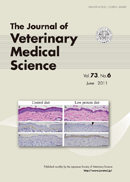Volume 73, Issue 6
June
Displaying 1-25 of 25 articles from this issue
- |<
- <
- 1
- >
- >|
Avian Pathology
-
Article type: NOTE
2011 Volume 73 Issue 6 Pages 837-840
Published: 2011
Released on J-STAGE: July 05, 2011
Advance online publication: January 28, 2011Download PDF (1564K)
Bacteriology
-
Article type: NOTE
2011 Volume 73 Issue 6 Pages 841-843
Published: 2011
Released on J-STAGE: July 05, 2011
Advance online publication: January 28, 2011Download PDF (567K)
Clinical Pathology
-
Article type: NOTE
2011 Volume 73 Issue 6 Pages 805-807
Published: 2011
Released on J-STAGE: July 05, 2011
Advance online publication: January 07, 2011Download PDF (1224K) -
Article type: NOTE
2011 Volume 73 Issue 6 Pages 849-851
Published: 2011
Released on J-STAGE: July 05, 2011
Advance online publication: February 03, 2011Download PDF (652K)
Ethology
-
Article type: FULL PAPER
2011 Volume 73 Issue 6 Pages 747-752
Published: 2011
Released on J-STAGE: July 05, 2011
Advance online publication: January 28, 2011Download PDF (567K)
Immunology
-
Article type: FULL PAPER
2011 Volume 73 Issue 6 Pages 773-778
Published: 2011
Released on J-STAGE: July 05, 2011
Advance online publication: February 04, 2011Download PDF (839K)
Laboratory Animal Science
-
Article type: FULL PAPER
2011 Volume 73 Issue 6 Pages 739-745
Published: 2011
Released on J-STAGE: July 05, 2011
Advance online publication: January 28, 2011Download PDF (1455K) -
Article type: NOTE
2011 Volume 73 Issue 6 Pages 831-835
Published: 2011
Released on J-STAGE: July 05, 2011
Advance online publication: January 28, 2011Download PDF (650K)
Parasitology
-
Article type: NOTE
2011 Volume 73 Issue 6 Pages 845-847
Published: 2011
Released on J-STAGE: July 05, 2011
Advance online publication: January 31, 2011Download PDF (639K)
Pathology
-
Article type: NOTE
2011 Volume 73 Issue 6 Pages 797-799
Published: 2011
Released on J-STAGE: July 05, 2011
Advance online publication: January 06, 2011Download PDF (1375K) -
Article type: NOTE
2011 Volume 73 Issue 6 Pages 801-803
Published: 2011
Released on J-STAGE: July 05, 2011
Advance online publication: January 06, 2011Download PDF (2994K)
Pharmacology
-
Article type: FULL PAPER
2011 Volume 73 Issue 6 Pages 733-738
Published: 2011
Released on J-STAGE: July 05, 2011
Advance online publication: January 19, 2011Download PDF (961K) -
Article type: NOTE
2011 Volume 73 Issue 6 Pages 817-820
Published: 2011
Released on J-STAGE: July 05, 2011
Advance online publication: January 12, 2011Download PDF (584K)
Physiology
-
Article type: FULL PAPER
2011 Volume 73 Issue 6 Pages 711-716
Published: 2011
Released on J-STAGE: July 05, 2011
Advance online publication: January 07, 2011Download PDF (778K) -
Article type: FULL PAPER
2011 Volume 73 Issue 6 Pages 787-795
Published: 2011
Released on J-STAGE: July 05, 2011
Advance online publication: February 07, 2011Download PDF (1330K)
Public Health
-
Article type: FULL PAPER
2011 Volume 73 Issue 6 Pages 779-786
Published: 2011
Released on J-STAGE: July 05, 2011
Advance online publication: February 07, 2011Download PDF (860K)
Surgery
-
Article type: FULL PAPER
2011 Volume 73 Issue 6 Pages 725-731
Published: 2011
Released on J-STAGE: July 05, 2011
Advance online publication: January 11, 2011Download PDF (1195K)
Theriogenology
-
Article type: FULL PAPER
2011 Volume 73 Issue 6 Pages 717-723
Published: 2011
Released on J-STAGE: July 05, 2011
Advance online publication: January 07, 2011Download PDF (1099K) -
Article type: NOTE
2011 Volume 73 Issue 6 Pages 809-812
Published: 2011
Released on J-STAGE: July 05, 2011
Advance online publication: January 11, 2011Download PDF (499K) -
Article type: NOTE
2011 Volume 73 Issue 6 Pages 827-829
Published: 2011
Released on J-STAGE: July 05, 2011
Advance online publication: January 26, 2011Download PDF (483K)
Toxicology
-
Article type: NOTE
2011 Volume 73 Issue 6 Pages 821-826
Published: 2011
Released on J-STAGE: July 05, 2011
Advance online publication: January 18, 2011Download PDF (1625K)
Virology
-
Article type: FULL PAPER
2011 Volume 73 Issue 6 Pages 753-758
Published: 2011
Released on J-STAGE: July 05, 2011
Advance online publication: January 28, 2011Download PDF (515K) -
Article type: FULL PAPER
2011 Volume 73 Issue 6 Pages 759-766
Published: 2011
Released on J-STAGE: July 05, 2011
Advance online publication: February 02, 2011Download PDF (717K) -
Article type: FULL PAPER
2011 Volume 73 Issue 6 Pages 767-772
Published: 2011
Released on J-STAGE: July 05, 2011
Advance online publication: February 03, 2011Download PDF (521K) -
Article type: NOTE
2011 Volume 73 Issue 6 Pages 813-816
Published: 2011
Released on J-STAGE: July 05, 2011
Advance online publication: January 11, 2011Download PDF (586K)
- |<
- <
- 1
- >
- >|
